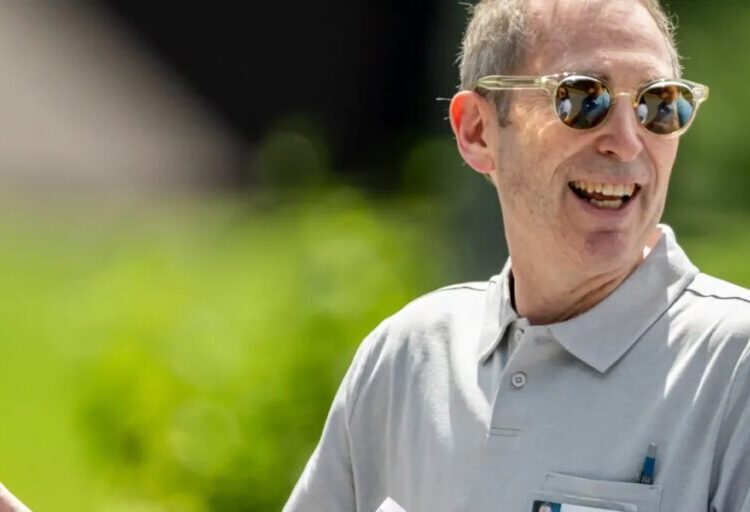When leaving an atoll of the Marshall Islands, in the South Pacific, Alson Kelen prefers to sail after sunset. It’s like navigating with his eyes closed — allowing him to feel the up, down and sideways movement of every swell.
“That’s how the Marshallese navigate,” he said. “They navigate with their stomach.”
For thousands of years, Marshallese navigators used traditional wave-piloting techniques to travel vast expanses of ocean. Wave piloting is the art of feeling and reading the swells and waves that hit and emanate from the region’s atolls. After a lifetime of studying these and other patterns, navigators pass a test devised by their chiefs to become a ri meto, or person of the sea.
In the mid-1940s through the 1950s, nuclear testing by the American military displaced some Indigenous populations of the Marshalls. The ancient and sacred art of wave piloting was kept alive by a small group of people, among them Capt. Korent Joel, one of the last known experts in traditional navigation, who trained his younger cousin, Mr. Kelen. Captain Joel died in 2017.
In early August, a team of international researchers, along with Marshallese sailors, set sail on a two-day voyage to study the cognitive process of way-finding at sea — and, more broadly, to help preserve the ancient art of navigation, which is having a cultural revival in the Pacific islands. Maria Ahmad, a Ph.D. student in cognitive neuroscience at University College London, devised the project after living on the Marshalls for many years. “I want to be part of keeping that heritage alive,” she said.
Humans find their way across cities and forests by relying on visual landmarks. But the ocean, an ever-changing environment with no fixed visual markers, presents a more complex — and higher-stakes — challenge for the brain.
A decade ago, researchers on a similar voyage documented Mr. Kelen’s understanding of the ocean as he sailed from one atoll, Majuro, to another, Aur, on a traditional Marshallese sailing canoe. The goal was to begin to understand how wave pilots successfully make their way from one destination to another despite the complexities of fluid dynamics. On board were an anthropologist, a physicist and an oceanographer, but no neuroscientists.
This time around, the researchers hoped to answer more cognitive questions: How do people know where they are at sea? And how can that skill set be preserved? The crew comprised neuroscientists, a philosopher, a Marshallese anthropologist and two Marshallese sailors. Every 30 minutes, the people aboard the vessel had to draw their location, or at least where they thought they were, on a map — including the direction that the waves seemed to be coming from. In what ways would the Marshallese sailors be more precise?
“What is it that they are getting right over the rest of us?” said Hugo Spiers, a neuroscientist at University College London who has studied navigation for more than two decades and was among the passengers. “I found it extremely hard to know where I was.”
Also on board were hundreds of pounds of technology: accelerometers to measure the boat’s speed; a watch on everyone’s wrist to measure heart rate; eye-tracking technology, to document where people were gazing; equipment to record brain activity relative to swell movement; a mounted 360-degree camera that captured changes in the sails and clouds; and more.
In earlier research, Pablo Fernandez Velasco, a philosopher at the University of Stirling in Scotland, spent months in Siberia studying the Evenki people, who are renowned for their ability to navigate dense forests without getting lost. That effort centered on listening to people’s stories, Dr. Fernandez Velasco said, and was less quantitative than the Marshalls project. “All of these tests that people are fulfilling and all this data that’s being collected — that’s very different, very novel and very promising,” he said.
Dr. Fernandez Velasco has also collaborated with Dr. Spiers to study the brains of London taxi drivers, revealing just how efficiently they can plan routes. Past research has shown that a taxi driver’s hippocampus, the part of the brain related to spatial memory, gets bigger over time. Unlike most people who get worse at navigating, London taxi drivers seem to get better at navigation over decades, Dr. Spiers said.
The findings from the Marshall Islands voyage could also have implications for the study and diagnosis of Alzheimer’s, the researchers said. With Alzheimer’s, the hippocampus becomes smaller over time, and disorientation is an early symptom.
That research could benefit residents of the Pacific islands, where there is a high incidence of Alzheimer’s but little public awareness. Because primary health care is poor, Ms. Ahmad said, “it’s hard to diagnose people and it’s hard to help people.” Explaining the disease requires complex translation, added Jerolynn Neikeke Myazoe, an anthropologist and translator on the voyage: “We don’t really have a specific word for it.”
Although the project is still in the early stages of processing data, Mr. Kelen, who leads a canoe and sailing school in the Marshalls, finds the project promising for the Marshallese. “The most relevant thing to do is look back on how our ancestors survived on these rocks,” he said. “This is the only weapon we have — our tradition, our culture.” He added: “A navigator is a culture-keeper of the ocean.”
Alexa Robles-Gil is a science reporter and a member of the 2025-26 Times Fellowship class, a program for journalists early in their careers.
The post A Voyage Into the Art of Finding One’s Way at Sea appeared first on New York Times.




